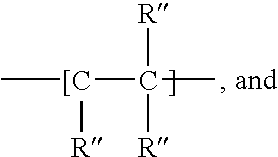Carbamate-functional resins having improved adhesion, method of making the same, and method of improving intercoat adhesion
- Summary
- Abstract
- Description
- Claims
- Application Information
AI Technical Summary
Benefits of technology
Problems solved by technology
Method used
Image
Examples
example i (
B-F)
Example IB
Preparation of a Carbamate Functional Polymer (Resin IB) According to the Invention
690.9 parts of n-methyl pyrrolidone was heated to 120° C. under an inert atmosphere. Then a mixture of 912 parts of the cyclic carbonate of glycidyl methacrylate, 228 parts of styrene, 114 parts of 2,2′-azobis(2-methylbutanenitrile) and 150 parts of n-methyl pyrrolidone was added over 2 hours and 15 minutes. The reaction mixture was held at 120° C. for two hours then cooled to room temperature. Then 1400 parts of methanol was added and ammonia gas added to the reaction mixture until the reaction was complete. During this time, 30 parts of the reaction mixture was removed for sampling. The excess ammonia and methanol were then removed by vacuum distillation and 791.6 parts of ∈ caprolactone added. The reaction mixture was then heated under an inert atmosphere to 86° C. 3.4 parts of Fascat® 2003 (Elf Atochem) was subsquently added and the reaction mixture heated to 130° C. The reaction mix...
example ic
Preparation of a Carbamate Functional Polymer (Resin IC) According to the Invention
690.9 parts of n-methyl pyrrolidone was heated to 120° C. under an inert atmosphere. A mixture of 912 parts of the cyclic carbonate of glycidyl methacrylate, 228 parts of n-butyl acrylate, 114 parts of 2,2′-azobis(2-methylbutanenitrile) and 150 parts of n-methyl pyrrolidone was then added over 2 hours and 45 minutes. The resulting reaction mixture was held at 120° C. for 1 hour and 40 minutes then cooled to room temperature. 1050 parts of methanol were then added and ammonia gas added to the reaction mixture until the reaction was complete. Excess ammonia and methanol were then removed by vacuum distillation and 791.6 parts of ∈ caprolactone added. The reaction mixture was then heated to 50° C. under an inert atmosphere. 3.44 parts of Fascat® 2003 was added and the reaction mixture heated to 130° C. The reaction mixture was held at 130° C. until the reaction was complete followed by the addition of 28...
example id
Preparation of a Carbamate Functional Polymer (Resin ID) According to the Invention
794.5 parts of amyl acetate was heated to reflux under an inert atmosphere and then cooled to 130° C. A mixture of 618.8 parts of isocyanato ethyl methacrylate, 421.9 parts of butyl acrylate, 105.3 parts of styrene, and 137.5 parts of 2,2′-azobis(2-methylbutanenitrile) was then added to the reaction mixture over 2 hours and 5 minutes. The resulting reaction mixture was held at 130° C. for 1 hour and 50 minutes, then cooled to room temperature. 0.7 parts of dibutyl tin dilaurate was then charged into the reaction mixture and 414 parts of hydroxy propyl carbamate added slowly to the reaction mixture and allowed to react. 50 parts of isobutyl alcohol was then added followed by 396.7 parts of amyl acetate. The resulting resin had a NV of 58.65% and a % nonfunctional monomer of approximately 31.2, based on the total weight of the polymer.
PUM
| Property | Measurement | Unit |
|---|---|---|
| Weight | aaaaa | aaaaa |
| Fraction | aaaaa | aaaaa |
| Percent by mass | aaaaa | aaaaa |
Abstract
Description
Claims
Application Information
 Login to View More
Login to View More - R&D
- Intellectual Property
- Life Sciences
- Materials
- Tech Scout
- Unparalleled Data Quality
- Higher Quality Content
- 60% Fewer Hallucinations
Browse by: Latest US Patents, China's latest patents, Technical Efficacy Thesaurus, Application Domain, Technology Topic, Popular Technical Reports.
© 2025 PatSnap. All rights reserved.Legal|Privacy policy|Modern Slavery Act Transparency Statement|Sitemap|About US| Contact US: help@patsnap.com



